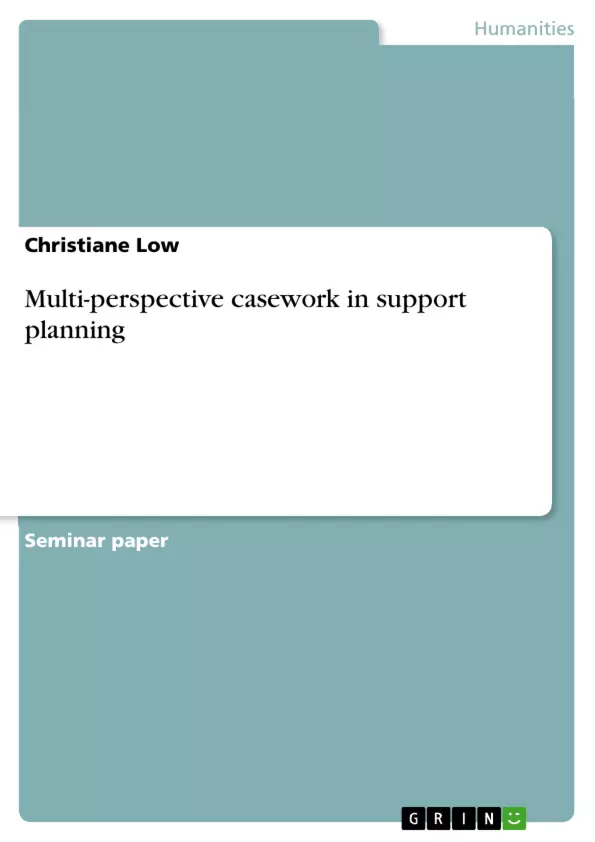Professional social work in its various forms addresses the diverse, complex relationships between people and their environment. It represents a whole network of values, theories and practice (cf. IFSW) and is as diverse as the lifeworld of people themselves. With the book "Sozialpädagogisches Können. Ein Lehrbuch zur multiperspektivischen Fallarbeit" (Social Pedagogical Skills: A Textbook on Multi-Perspective Casework), first published in 1993, Burkhard Müller intends to show that the diversity of social work can be ordered in a relatively clear pattern. He calls this pattern multi-perspective casework.
Whether this method succeeds in structuring the complexity of social pedagogical action through the case-related processing of the levels and phases named by Müller and making them transparent for the person acting is the central question of this paper.
The case perspectives and the work phases of multi-perspective approaches are to be explained in the paper. The extent to which this is a method that takes into account the complex conditions of social work as well as the specific legal requirements of the Child and Youth Welfare Act will be shown using the example of support planning. Finally, a conclusion and an assessment of the effectiveness of this model as a method of social work will follow.
Inhaltsverzeichnis (Table of Contents)
- Introduction
- Aid planning in the Child and Youth Welfare Act
- Multi-perspective casework
- Dimensions of case work - case of, case for, case with
- Socio-educational anamnesis
- Socio-educational diagnosis
- Socio-educational intervention
- Socio-pedagogical evaluation
- Multi-perspective casework in support planning
- Conclusion
Zielsetzung und Themenschwerpunkte (Objectives and Key Themes)
The aim of this paper is to examine the effectiveness of multi-perspective casework as a method for structuring and making transparent the complexity of socio-pedagogical action. The paper explores how the case perspectives and work phases of the multi-perspective approach can be applied to the context of aid planning within the Child and Youth Welfare Act. The analysis focuses on the extent to which this method effectively addresses both the complex operating conditions of social work and the specific legal requirements of the Act.
- The application of multi-perspective casework in social work.
- The importance of case-related work and its historical development.
- The role of aid planning in the Child and Youth Welfare Act.
- The legal requirements for granting longer-term "aids to education" in the Act.
- The need for a method that effectively addresses both the complex operating conditions of social work and the specific legal requirements of the Act.
Zusammenfassung der Kapitel (Chapter Summaries)
- Introduction: This chapter introduces the concept of multi-perspective casework and its potential for structuring and clarifying socio-pedagogical action. It highlights the complexity of social work and the need for a method that addresses the diverse needs and perspectives involved.
- Aid planning in the Child and Youth Welfare Act: This chapter delves into the legal framework surrounding aid planning within the Child and Youth Welfare Act, highlighting the key provisions and requirements for granting "aids to education." It emphasizes the shift towards social service authority and the importance of promoting positive living conditions for children and families.
- Multi-perspective casework: This chapter explores the concept of multi-perspective casework in detail, examining its history, key elements, and application in social work practice. It discusses the importance of case-related work and the need to consider multiple perspectives in assessing and addressing social problems.
Schlüsselwörter (Keywords)
The key words and focus topics of this text include: multi-perspective casework, socio-pedagogical casuistry, aid planning, Child and Youth Welfare Act, legal requirements, case perspectives, work phases, social work practice, operating conditions, and professionalization.
- Arbeit zitieren
- Christiane Low (Autor:in), 2008, Multi-perspective casework in support planning, München, GRIN Verlag, https://www.grin.com/document/1154723



